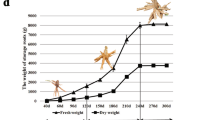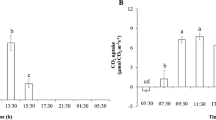Abstract
Quantitative histochemistry was used to investigate the tissue-specific compartmentation of soluble carbohydrates (sucrose, glucose, fructose), starch and malate in the laminar pulvinus, leaf blade and petiole of Phaselous coccineus L. at day and night positions of diurnal leaf movement. Total carbohydrate levels measured in a series of cross sections along individual pulvini of 24-d-old plants showed only small differences between the day and night positions of the respective leaf. In contrast, the level of malate changed during diurnal leaf movement, especially in the central part of a pulvinus. The levels of glucose and fructose in the pulvinus increased towards the transition zones between the pulvinus and lamina, and pulvinus and petiole, and this trend was even more pronounced for starch. By contrast, sucrose levels were highest in the pulvinus proper. The transverse compartmentation of metabolites was studied in distinct, approx. 0.5-mm-thick tissue slices from the central part of a pulvinus. These were dissected further into up to 14 distinct subsamples (bundle, bundle sheath, motor tissues, flanks). Irrespective of the position of the leaf (day or night), the central vascular core and the surrounding bundle sheath had high levels of sucrose (up to 500 mmol-(kg DW)−1) and low levels of glucose and fructose (below 100 mmol-(kg DW)−1), while in the cortex the situation was reversed. In the night position the level of sucrose decreased by approx. 30% in the bundle sheath and the central vascular core but not in the other sections. We thus suggest that because of the relatively small diurnal changes in their cortical pools, soluble sugars are not involved in the osmotic processes resulting in leaf movement. In contrast, pulvini from 14-d-old plants showed an interesting diurnal change in starch and malate pools in the outermost layer of the extensor. Here starch increased at night while the malate pool was lowered nearly stoichiometrically. Inverse pool sizes were found in the day position of the respective leaves. Although less significant, the opposite diurnal variation occurred in samples taken from the flexor region. We thus were able to locate areas of different carbohydrate activities in the laminar pulvinus of P. coccineus. The central vascular core, including the bundle sheath, is involved in temporary storage of photoassimilates, and the cortical regions are responsible for osmotically driven leaf movement. The results are discussed with respect to guard-cell physiology.
Similar content being viewed by others
Abbreviations
- CLP:
-
cut-leaf pulvini
- ILP:
-
intact-leaf pulvini
References
Beutler, H-O. (1984) Starch. In: Methods of enzymatic analysis, 3rd edn. vol. VI, pp. 2–10, Bergmeyer, H.V., ed. Verlag Chemie, Weinheim
Bialczyk, J., Lechowski, Z. (1986) Diurnal changes in the malic acid concentration in Phaseolus coccineus L. pulvini. Plant Cell Physiol. 27, 981–987
Bialczyk, J., Lechowski, Z. (1989) Malic acid synthesis in relation to K+ and Cl− availability in Phaseolus coccineus L. pulvini. Biochem. Physiol. Pflanzen 184, 79–86
Bialczyk, J., Lechowski, Z. (1990) Influence of a potassium-channel blocker and metabolic and ATPase inhibitors on potassium and malate content of Phaseolus coccineus L. Pulvini. New Phytol. 115, 595–601
Bünning, E. (1934) Die Mechanik der tagesperiodischen Variations-bewegungen von Phaseolus multiflorus. Jahrb. Wiss. Bot. 79, 191–230
Bünning, E. (1936) Die tagesperiodischen Variationsbewegungen. Erg. d. Biol. 13, 312–339
Bünning, E. (1959) Tagesperiodische Bewegungen. In: Handbuch der Pflanzenphysiologie, vol. XVII/1: Physiologie der Bewegungen, pp. 579–656, Ruhland, W., ed. Springer, Berlin Heidelberg New York
Dekker, R.F.H., Richards, G.N. (1971) Determination of starch in plant material. J. Sci. Food Agric. 22, 441–444
Einig, W., Hampp, R. (1990) Carbon partitioning in Norway spruce: amounts of fructose 2,6-bisphosphate and of intermediates of starch/sucrose synthesis in relation to needle age and degree of needle loss. Trees 4, 9–15
Erath, F., Ruge, W.A., Mayer, W.-A., Hampp, R. (1988) Isolation of functional extensor and flexor protoplasts from Phaseolus coccineus L. pulvini: potassium induced swelling. Planta 173, 447–152
Ettel, W. (1981) Eine neue enzymatische Stärkebestimmung für Lebensmittel. Alimenta 20, 7–11
Giaquinta, R.T. (1983) Phloem loading of sucrose. Annu. Rev. Plant Physiol. 34, 347–387
Gorton, H.L. (1990) Stomates and pulvini: a comparison of two rhythmic, turgor-mediated movement systems. In: The pulvinus: Motor organ for leaf movement, pp. 223–237, Satter, R.L., Gorton, H.L., Vogelmann Th.C., eds. Am. Soc. Plant Physiol., Rockville
Hampp, R., Outlaw Jr., W.H., Ziegler, H. (1987) Quantitative histochemical analysis of starch, malate and K+, together with the activity of phospho-enolpyruvate carboxylase along elongating primary leaf of hordeum vulgare. Z. Naturforsch. 42c, 1092–1096
Hampp, R., Rieger, A., Outlaw Jr., W.H. (1990) Microdissection and biochemical analysis of plant tissues. In: Physical methods in plant sciences, pp. 124–147, Linskens, H.F., Jackson, J.F., eds. Springer-Verlag, Berlin Heidelberg New York Tokyo
Hosokawa, Y., Kiyosawa, K. (1983) Diurnal K+ and anion transport in Phaseolus pulvinus. Plant Cell Physiol. 24, 1065–1072
Jones, M.G.K., Outlaw Jr., W.H. (1981) Enzymic assay for sucrose. In: Techniques in carbohydrate metabolism, B302, pp. 1–8, Kornberg, H.L., ed. Elsevier/North-Holland Scientific Publishers Ltd., Amsterdam
Kiyosawa, K. (1979) Examination of analytical methods for ions and saccharides in the extract of Phaseolus pulvini. Plant Cell Physiol. 20, 1609–1619
Lowry, O.H., Passonneau, J.V. (1972) A flexible system of enzymatic analysis. Academic Press, New York San Francisco London
Mayer, W.-E. (1977) Kaliumnd Chloridverteilung im Laminar gelenk von Phaseolus coccineus L. während der circadianen Blattbewegung im tagesperiodischen Licht-Dunkelwechsel. Z. Pflanzenphysiol. 83, 127–135
Mayer, W.-E., Ruge, W.A., Starrach, N., Hampp, R. (1987) Chloride availability affects the malate content and its control by the circadian clock in pulvini of Phaseolus coccineus L. Z. Naturforsch. 42c, 553–558
Minchin, P.E.H, Thorpe, M.R. (1987) Measurement of unloading and reloading of photo-assimilate within the stem of bean. J. Exp. Bot. 38, 211–220
Mosebach, G. (1940) Untersuchungen über die tagesperiodische Bewegung der Blattgelenke von Phaseolus. Jahrb. Wiss. Bot. 89, 20–88
Outlaw Jr., W.H. (1982) Carbon metabolism in guard cells. In: Cellular and subcellular localisation in plant metabolism, pp. 185–172, Creasy, L.L., Hrazdina, G., eds. Plenum Publishng Corporation, London New York San Francisco
Racusen, R.H., Galston, A.W. (1977) Electrical evidence for rhythmic changes in the cotransport of sucrose and hydrogen ions in Samanea pulvini. Planta 135, 57–62
Rieger, A. (1990) Verteilung von Metaboliten und Enzymaktivitäten im Laminargelenk und anderen Blattgeweben von Phaseolus coccineus L., bestimmt unter Anwendung der quan titativen Histochemie. Dissertation, University of Tübingen, Tübingen, FRG
Rieger, A., Hampp, R. (1991) Intercellular compartmentation of basic carbon pathways in motor organs (pulvini) of leaves of Phaseolus coccineus L. Planta 184, 415–421
Rieger, A., Ruge, W.A., Hampp, R. (1987) Malaie gradients in secondary pulvini of Phaseolus coccineus L. (Abstr.) Plant Physiol. 83, Suppl., 158
Ruge, W.A., Hampp, R. (1987) Leaf movements of nyctinastic plants — review. Plant Physiol. (Life Sci. Adv.) 6, 149–158
Sachs, L., ed. (1988) Statistische Methoden: Planung und Auswertung. 6. Aufl., Springer-Verlag Berlin Heidelberg New York London Paris Tokyo
Satter, R.L., Applewhite, P.B., Chaudhri, J., Galston, A.W. (1976) Pfr phytochrome and sucrose requirement for rhythmic leaflet movement in Albizzia. Photochem. Photobiol. 23, 107–112
Satter, R.L. (1979) Leaf movements and tendril curling. In: Encyclopedia of Plant Physiology, N.S. vol. 7, pp. 442–484, Haupt W., Feinleib, M.E., eds. Springer-Verlag, Berlin Heidelberg New York
Satter, R.L., Campbell, N.A. (1980) Nyctinastic leaf movements: hands of the biological clock. What's New Plant Physiol. 11, 13–16
Satter, R.L., Geballe, P.B., Applewhite, P.B., Galston, A.W. (1974) Potassium flux and leaf movement in Samanea saman. I. Rhythmic movement. J. Gen. Physiol. 64, 413–430
Satter, R.L., Morse, M.J., Lee, Y., Crain, R.C., Coté, G.G., Moran, N. (1988) Light- clock-controlled leaflet movements in Samanea saman, a physiological and biochemical analysis. Bot. Acta 101, 205–213
Satter, R.L., Gorton, H.L., Vogelmann, T.C. (1990) The pulvinus: motor organ for leaf movement, pp. 1–264. Am. Soc. Plant Physiol., Rockville
Simon, E., Satter, R.L., Galston, A.W. (1976) Circadian rhythmicty in excised Samanea pulvini. I. Sucrose-white light interactions. Plant Physiol. 58, 417–420
Starrach, N., Mayer, W.-E. (1989) Changes of the apoplastic pH and K+ concentration in the Phaseolus pulvinus in situ in rela tion to rhythmic leaf movements. J. Exp. Bot. 40, 865–873
Sung, S.-J., Xu, D.-P., Galloway, C.M., Black Jr., C.C. (1988) A reassessment of glycolysis and gluconeogenesis in higher plants. Physiol. Plant. 72, 650–654
Vanhinsberg, N., Horton, R.F. (1990) Carbon dioxide assimilation in pulvini of Phaseolus vulgaris. Biochem. Physiol. Pflanzen 186, 37–42
Wardlaw, I.F. (1990) The control of carbon partitioning in plants. New Phytol. 116, 341–381
Ziegler, H. (1975) Phloem transport. Nature of transported substances. In: Encyclopedia of Plant Physiol., N.S. vol. 1, pp. 59–100, Zimmermann, M.H., Milburn, J.A., eds. Springer-Verlag, Berlin Heidelberg New York Tokyo
Author information
Authors and Affiliations
Additional information
This work was supported by a grant from the Deutsche Forschungsgemeinschaft.
Rights and permissions
About this article
Cite this article
Rieger, A., Lutz, A. & Hampp, R. Compartmentation of soluble carbohydrates, of starch and of malate in motor organs (pulvini) and other parts of Phaseolus coccineus L. leaves. Planta 187, 95–102 (1992). https://doi.org/10.1007/BF00201629
Accepted:
Issue Date:
DOI: https://doi.org/10.1007/BF00201629




